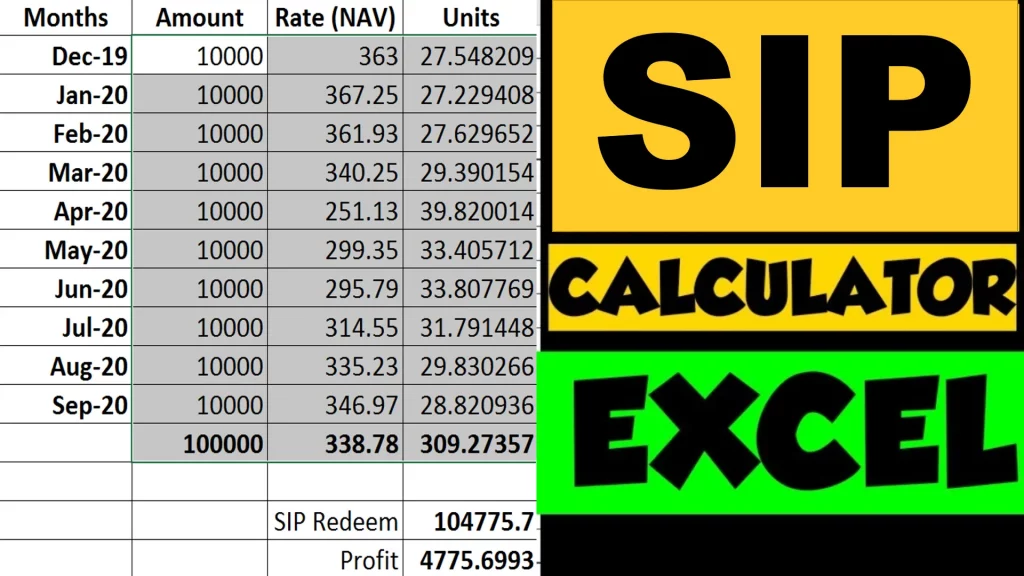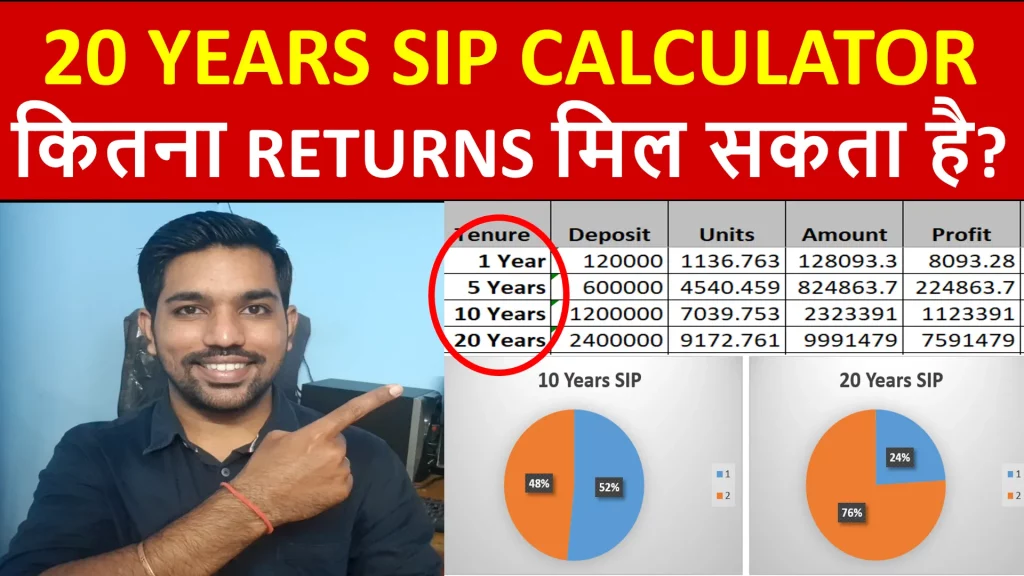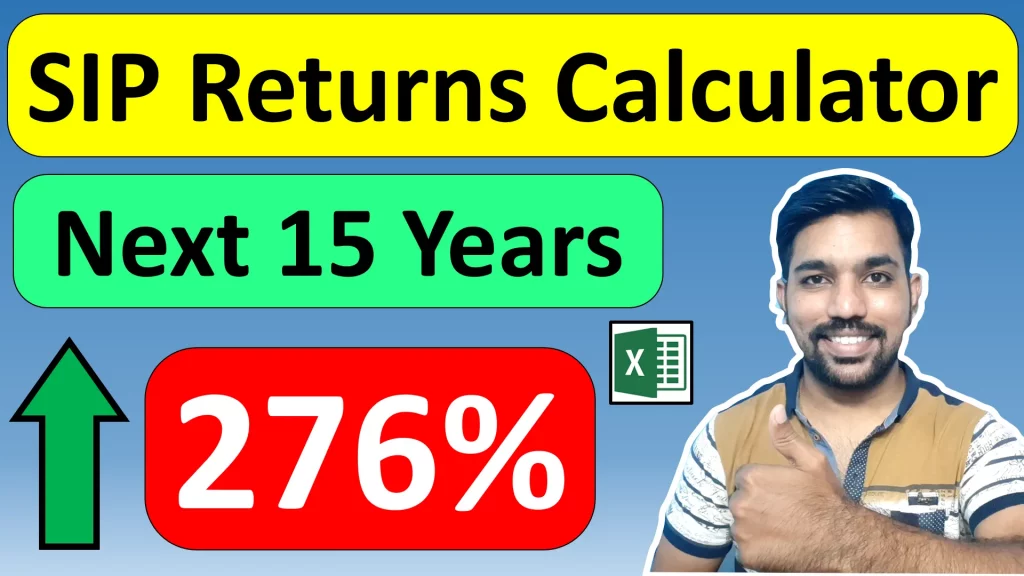What is SIP, is one of the important question for which you should know the answer in order to be financially stable in today’s world. SIP stands for Systematic Investment Plan, which is a way to invest specific amount in mutual funds every month to achieve your financial goals. It provides multiple benefits including Rupee Cost Averaging, Compounding, Disciplined investments, better returns, flexibility with investments, etc.
Let us understand What is SIP in detail along with examples and calculations.
What is SIP?
- SIP full form is Systematic Investment Plan
- It is a method of investing a fixed amount of money regularly (monthly, quarterly, etc.) into mutual funds to achieve financial goals like buying a new house, new car, children’s further education, etc.
- It aims at financial discipline and promote regular savings and investments while you are actively working on a job or business
- SIPs automate investments with auto-debits from your bank account based on standing instructions, making it easier for individuals to invest without needing to time the market or putting manual efforts
- By investing regularly, SIPs help average out the purchase cost of units over time, reducing the impact of market volatility. This is called Rupee cost Averaging
- With time, the returns on the invested amount also earn returns, which can lead to wealth creation through the power of compounding
- Investors can start, stop, or modify their SIPs as per their financial needs in mutual funds
- They are accessible to a wide range of investors due to the low initial investment requirement. You can start investing with as low as Rs. 500
How SIP works?
Let us understand how Systematic Investment Plan works with the help of example:
Let’s say Arjun, a 30 year old professional, decides to start SIP in a mutual fund. He chooses a fund that aligns with his long-term financial goals, such as buying a house or saving for retirement. Arjun decides to invest Rs. 5000 every month through Systematic Investment Plan.
At the beginning of each month, Rs. 5000 is automatically debited from Arjun’s bank account and invested in the chosen mutual fund based on instructions given to his bank account. The number of units he buys each month depends on the current Net Asset Value (NAV) of the fund. If the NAV is Rs. 50, he buys 100 units. If the NAV is Rs. 40, he buys 125 units. This process is known as rupee cost averaging, as it helps to spread out his investment over time and reduces the impact of market volatility.
With time, Arjun continues his monthly SIP investments. Some months, the market is up, and the NAV is higher, so he buys fewer units. Other months, the market is down, and the NAV is lower, so he buys more units. Remember that this buying is automatic without any manual efforts, and Arjun is focused on his primary job or business. By investing regularly regardless of market conditions, he averages out the cost of his investments and minimizes the risk of market timing.
Additionally, Arjun benefits from compounding as well. The returns he earns on his investments are reinvested (units are not redeemed), generating further returns. With time, this compounding effect can significantly grow his wealth. For example, if Arjun’s investment grows at an average annual rate of 12%, after 20 years, his monthly SIP of Rs. 5000 could grow to approximately Rs. 50 lakhs.
Below is the screenshot of the amount taken from fincalc SIP Calculator:

Arjun regularly tracks his SIP investments, also reviews the performance of the mutual fund, and makes adjustments if needed. For example, he might increase his SIP amount as his income grows, or he may switch to a different fund for better returns or financial goals change.
Increasing SIP amount regularly to achieve financial goals before time is called Step up SIP. In step up, you increase the amount after every year based on the increase in income, bonus, increments and other reasons.
By investing through Systematic Investment Plan, Arjun has a disciplined approach to wealth creation, taking advantage of market volatility and the power of compounding to achieve his financial goals.
Rs. 2000 SIP Returns Calculation Video
Watch below video to understand SIP Returns Calculation for 15 years with Rs. 2000 monthly deposits:

Watch more Videos on YouTube Channel
Benefits of SIP
Below are some of the benefits of Systematic Investment Plan that we understood with above example:
- Financial Discipline: SIP Encourages regular savings and investment helping you to create good financial habits
- Rupee Cost Averaging: It reduces the impact of market volatility by averaging the purchase cost of units over time. You buy less units when market is up and more units when market is down
- Compounding: Helps in wealth creation over the long term through the power of compounding, by retaining mutual fund units
- Flexibility: It allows investors to start, stop, or modify their SIPs as per their financial goals and needs. You can start with as low as Rs. 500 monthly deposits in mutual funds
- Convenience: Automated investments make it easy to invest regularly without needing to time the market and putting manual efforts
- Goal-Oriented: Systematic Investment Plan helps in achieving various financial goals, such as buying a house, children’s further education, or planning for retirement. You can use Retirement Calculator to understand how much amount you need to accumulate before retirement
So these are some of the benefits in Systematic Investment Plan.
What is the SIP 5000 per month for 10 years?
With Rs. 5000 per month for 10 years and expected returns of 12% every year, you can get approximately Rs. 11.6 Lakh as maturity amount. Below is the screenshot for same from fincalc SIP calculator:

Why to start SIP in mutual fund?
You should start SIP in mutual fund due to following reasons:
- Achieve financial goals using systematic plan that helps you be disciplined and consistent
- Take advantage of better returns from markets as compared to conventional interest amounts from savings account, fixed deposits, recurring deposits, etc.
- Get compounding benefits that will help you earn returns on existing returns you have earned when you keep the mutual fund units over long term
- Systematic Investment Plan also help you to retire early, which can help you follow your passion after your retirement from 9 to 5 job
Watch below video to understand how to start SIP online
How to Start SIP online Video

Is SIP better than FD?
FD or fixed deposits is safe investment option and is better for your short term goals of 1 year to 3 years compared to SIP. FD provides you guaranteed returns whereas the returns from SIP is not guaranteed.
But historically, we have seen that SIP returns from mutual fund beats FD returns, so it depends on your financial goals. If you goal tenure is within 1 year to 3 years than you should invest in FD (Fixed Deposit) and stay away from mutual fund Systematic Investment Plan.
But if your goal is long term with 7 years or more tenure, than you should invest in mutual funds via Systematic Investment Plan.
Some more Reading:
Save Home Loan Interest Amount!
Use Home Loan Excel Calculator that will help you to Save Interest Amount on Home Loan EMI.
Click below button to download Home Loan EMI and Prepayment Calculator in Excel:
Watch how Home Loan Calculator in Excel Works
Income Tax Calculator App – FinCalC
For Income Tax Calculation on your mobile device, you can Download my Android App “FinCalC” which I have developed for you to make your income tax calculation easy.
What you can do with this mobile App?
- Calculate Income Tax for FY 2025-26 and previous FY 2024-25
- Enter estimated Investments to check income tax with Old and New Tax Regime
- Save income tax details and track regularly
- Know how much to invest more to save income tax
- More calculators including PPF, SIP returns, Savings account interest and lot more

Use Popular Calculators:
- Income Tax Calculator
- Home Loan EMI Calculator
- SIP Calculator
- PPF Calculator
- HRA Calculator
- Step up SIP Calculator
- Savings Account Interest Calculator
- Lump sum Calculator
- FD Calculator
- RD Calculator
- Car Loan EMI Calculator
- Bike Loan EMI Calculator
- Sukanya Samriddhi Calculator
- Provident Fund Calculator
- Senior Citizen Savings Calculator
- NSC Calculator
- Monthly Income Scheme Calculator
- Mahila Samman Savings Calculator
- Systematic Withdrawal Calculator
- CAGR Calculator
I’d love to hear from you if you have any queries about Personal Finance and Money Management.
JOIN Telegram Group and stay updated with latest Personal Finance News and Topics.
Download our Free Android App – FinCalC to Calculate Income Tax and Interest on various small Saving Schemes in India including PPF, NSC, SIP and lot more.
Follow the Blog and Subscribe to YouTube Channel to stay updated about Personal Finance and Money Management topics.





